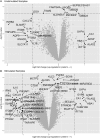Influenza-Induced Interferon Lambda Response Is Associated With Longer Time to Delivery Among Pregnant Kenyan Women
- PMID: 32256497
- PMCID: PMC7089959
- DOI: 10.3389/fimmu.2020.00452
Influenza-Induced Interferon Lambda Response Is Associated With Longer Time to Delivery Among Pregnant Kenyan Women
Abstract
Specific causes of preterm birth remain unclear. Several recent studies have suggested that immune changes during pregnancy are associated with the timing of delivery, yet few studies have been performed in low-income country settings where the rates of preterm birth are the highest. We conducted a retrospective nested case-control evaluation within a longitudinal study among HIV-uninfected pregnant Kenyan women. To characterize immune function in these women, we evaluated unstimulated and stimulated peripheral blood mononuclear cells in vitro with the A/California/2009 strain of influenza to understand the influenza-induced immune response. We then evaluated transcript expression profiles using the Affymetrix Human GeneChip Transcriptome Array 2.0. Transcriptional profiles of sufficient quality for analysis were obtained from 54 women; 19 of these women delivered <34 weeks and were defined as preterm cases and 35 controls delivered >37 weeks. The median time to birth from sample collection was 13 weeks. No transcripts were significantly associated with preterm birth in a case-control study of matched term and preterm birth (n = 42 women). In the influenza-stimulated samples, expression of IFNL1 was associated with longer time to delivery-the amount of time between sample collection and delivery (n = 54 women). A qPCR analysis confirmed that influenza-induced IFNL expression was associated with longer time to delivery. These data indicate that during pregnancy, ex vivo influenza stimulation results in altered transcriptional response and is associated with time to delivery in cohort of women residing in an area with high preterm birth prevalence.
Keywords: immune; influenza virus; interferon; pregnancy; preterm; time to delivery.
Copyright © 2020 Seiler, Bayless, Vergara, Pintye, Kinuthia, Osborn, Matemo, Richardson, John-Stewart, Holmes and Blish.
Figures


References
-
- Blencowe H, Cousens S, Oestergaard MZ, Chou D, Moller A-B, Narwal R, et al. National, regional, and worldwide estimates of preterm birth rates in the year 2010 with time trends since 1990 for selected countries: a systematic analysis and implications. Lancet. (2012) 379:2162–72. 10.1016/S0140-6736(12)60820-4 - DOI - PubMed
-
- World Health Organization Born too Soon: the Global Action Report on Preterm Birth. (2012). Available at: https://apps.who.int/iris/bitstream/handle/10665/44864/9789244503430_rus... (accessed March 05, 2020).
Publication types
MeSH terms
Substances
Grants and funding
LinkOut - more resources
Full Text Sources
Other Literature Sources
Molecular Biology Databases

